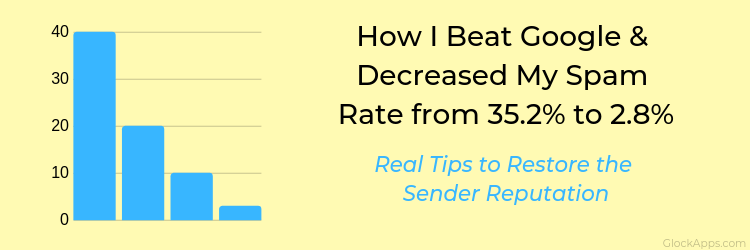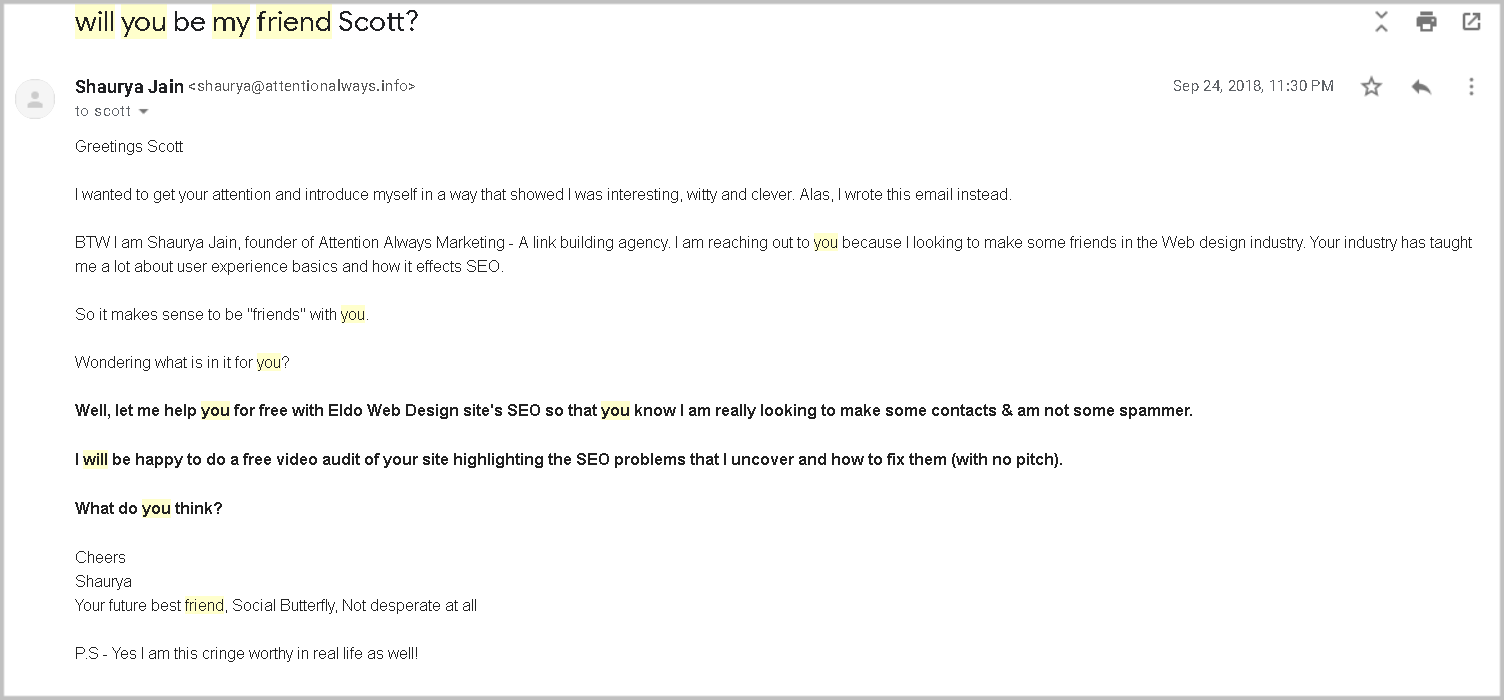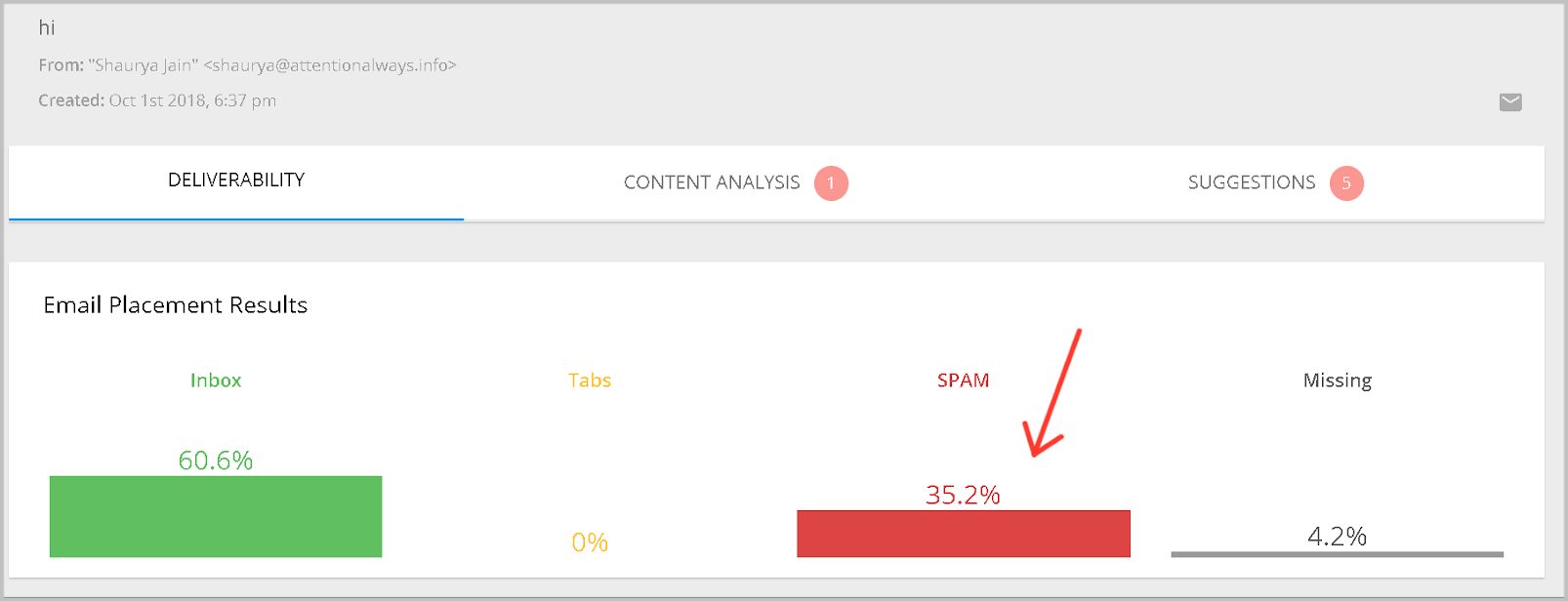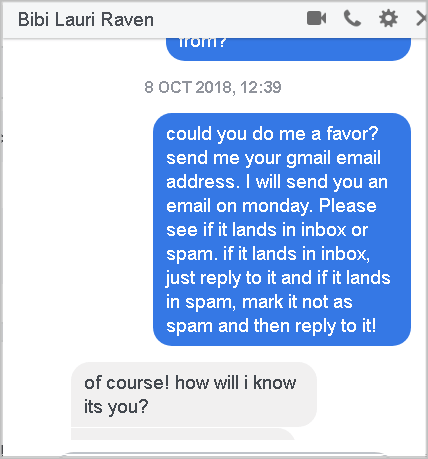How I Beat Google & Decreased My Spam Rate from 35.2% to 2.8%
This is the guest post written by Shaurya Jain.
A Mistake that Started It All
A couple of months ago, I launched a cold email campaign to partner with non-competing but closely related businesses. These were primarily PR and web design agencies.
From my 2 years of experience with cold emailing, I had learned that people like humorous cold emails.
Humor softened the blow of being pitched by some stranger.
It made the medicine sweeter, hence easier to consume.
It released little shots of dopamine in the recipient’s mind.
It kept their attention…. well you get the idea of what humor can do.
I decided to take humor to the next level…. by making it cringy.
Making it a cringefest was not the mistake I made. Not knowing which part of the email to leave out was my mistake. (Hint: the subject line)
I used this email copy to partner up with agencies:
Greetings Scott,
I wanted to get your attention and introduce myself in a way that showed I was interesting, witty and clever. Alas, I wrote this email instead.
BTW I am Shaurya Jain, founder of Attention Always Marketing – A link building agency. I am reaching out to you because I looking to make some friends in the Web design industry. Your industry has taught me a lot about user experience basics and how it effects SEO.
So it makes sense to be “friends” with you.
Wondering what is in it for you?
Well, let me help you for free with MyBrotherSteve.com site’s SEO so that you know I am really looking to make some contacts & am not some spammer.
I will be happy to do a free video audit of your site highlighting the SEO problems that I uncover and how to fix them (with no pitch).
What do you think?
Cheers
Shaurya
Your future best friend, Social Butterfly, Not desperate at allP.S – Yes I am this cringe-worthy in real life as well!
And this subject line to go along with the email:
Will you be my friend Scott?
Using this subject line led me to a 35% spam box rate (which I later recovered with the tips outlined below).
From my point of view, this subject line made complete sense. But it made complete sense to ME because I had read the body of the email. I knew the context behind “Will you be my friend”.
What I did not realize is that the recipient sees the subject line first and decides if he or she is going to open it, then they read the body of the email (where they get the context).
But if the subject line looks so spammy, no one cares to open the email to know what it is about.
People assume the worst.
How I Came to Know about my Domain’s Deliverability Issue
I got an open rate of X. Even my worst performing email campaigns before this had an open rate 3xf higher.
But the low open rate was not the worst part.
The worst part was people marking it as spam. People marking your emails as spam gives you a poor rating with your email service provider, can lead to more emails hitting the spam folder, and can affect your personal brand image. How do I know they marked it as spam?
I tested my domain with our beloved tool which revealed the messed up state of the domain with 35% of my emails going to spam.
The first takeaway for you is not to make your subject line over the top.
Keep it simple.
What I Did to Restore my Domain’s Reputation & Reduce the Spam Rate from 35% to 2%
The first thing I did was to read the Glockapps list of suggestions carefully.
I implemented the advice of removing the URLs from my email. My signature had two links – Linkedin Profile URL and Website URL.
I know that including social profile URLs is important to look more trustworthy and like a real person. But I realized that including your phone number could do the same thing. So that was the first change I made.
The second thing was to remove the website URL. This one was easy to omit because if someone wants to know more about you, they can always get your website URL from your email address.
After making these two changes I tested again with Glockapps and my scores certainly improved, but there was still a room for improvement.
My next steps could have been requesting the two blacklists to remove my domain from their lists, X or Y but I decided to do something different.
As a true organic SEO consultant, I thought to myself, “In SEO, we know Google takes inbound links as a serious ranking factor. That is why we go and build links to our site proactively instead of waiting for them. So why not do the same for replies? Let’s proactively get them.”
After this internal monologue, I went on to ask a couple dozen of my friends for their Gmail email address. Most had one.
Then I told them to look out for my email associated with my domain. It might even land in the spam box. I asked them to mark it “not spam” if that was the case and reply to it.
After I got their replies, I replied them back with a question to carry on the conversation. After carrying on such conversations over a couple of days, I tested again with GlockApps.
95% inbox rate! BOOM SHAKA LAKA
What I learned from this experiment is that just like when people mark an email as SPAM and make Google think it’s SPAM, by replying to an email and not marking it as SPAM, Google will believe it’s a quality email.
This does not mean that you should write low-quality emails, spam people, then recover your email reputation later.
Always write personalized emails to a targeted segment of people and if you make a mistake like me while experimenting, use this solution as an antidote.
In the long run, only genuine and honest marketers succeed.
Read more about Gmail Spam:
IP Blacklist Removal – How To Fix a Blacklisted IP Address
Avoiding Gmail Spam After the Latest Security Update
How to Remove Your IP Address from Gmail’s Blacklist
Gmail Puts Emails to Spam. How Can I Fix It?








